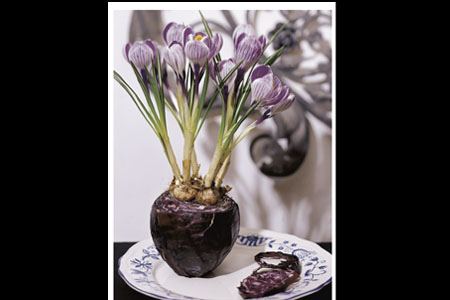
Flowers in Winter
Issue 100
First Published on November/December 2004
To access the issue page, click here
Flowering bulbs are normally associated with start of spring and early summer, but did you know that there is a wide variety of bulbs that can be grown during the winter months especially December and January? These flowers are very welcome during this time of the year as they bring a welcome splash of colour, beauty and even scent when outside in the garden there is very often little in the way of attractive plants.
Which bulbs to use?
The delicious smelling hyacinth is the most popular bulb for forcing but the following bulbs are all suitable for indoor growing and are readily available from garden centres, DIY stores and even supermarkets. Look out for bulbs that have already been forced, in which case all you need to do is to plant them up and wait for them to flower.
Containers
Use anything to hand from a jam jar, a plastic pot, an ornamental bowl or even organic matter such as a hollowed out onion! You are only limited by your imagination. You can create simple bright splashes of colour, or you can go for a look that is more sophisticated by using muted tones.
What do you do?
So how do you use bulbs indoors in the winter? Well, the key to successful winter-flowering bulbs is to specially prepare the bulbs so that they flower earlier that they normally would ie in winter rather that in spring. This procedure is known as ‘forcing’ and basically it involves keeping the bulbs in the dark to induce them to flower early, usually by the middle of winter. Buy the bulbs in early autumn. Plant them in containers that have already been filled with bulb fibre. Moisten the bulb fibre well before planting. Place the bulbs so that their tops are slightly visible and not completely covered.
Put the containers in a place that is cool and dark, in a cupboard or shed. Water the bulb fibre slightly if it starts to get dry. Leave the containers for about six to eight weeks, until you notice the new shoots emerging and the flower buds are just visible. Bring the bulbs out into the light, but be sure not to place them in direct sunlight. If you are planting daffodils, they usually require more light so place these on a sunny windowsill.
Top tips
Use contrasting colours and materials that combine liveliness with the natural loveliness of the plants.
Look for bright blooms and use striking containers. A single red amaryllis in a strong blue pot makes a stylish statement.
Mix and match natural materials such as wood, canvas and ceramic pots with artificial materials such as plastic. A row of brightly coloured plastic pots planted up with blue grape hyacinth is enough to brighten up any gloomy winter’s day.
Bulbs grown in containers make wonderful gifts. Try them as an alternative present for a friend or neighbour.
Aftercare
On the whole it’s best to discard bulbs after they have been forced, as they don’t perform too well subsequently. You can, if you choose, plant them out in the garden where they may flower again.
Bookmark this |
|
Add to DIGG |
|
Add to del.icio.us |
|
Stumble this |
|
Share on Facebook |
|
Share this |
|
Send to a Friend |
|
Link to this |
|
Printer Friendly |
|
Print in plain text |
|

Comments
0 Comments